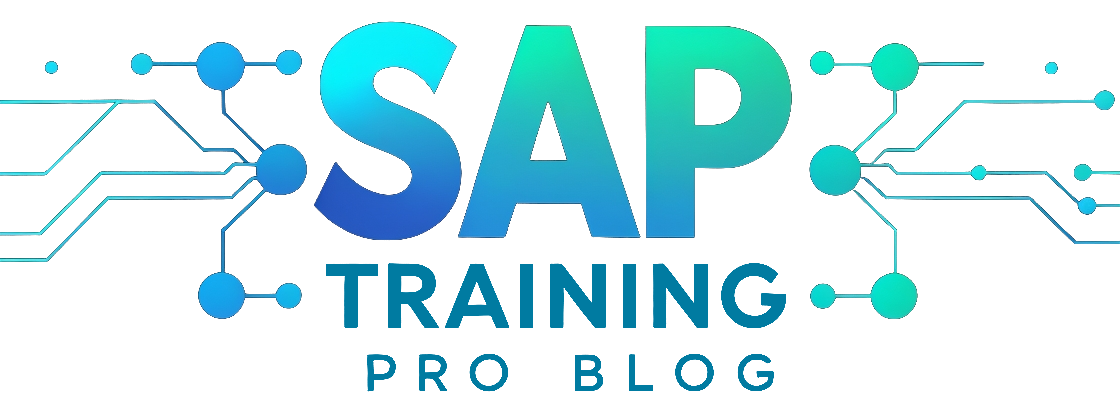SAP SD module: Master the Ins and Outs of SAP SD Module

The SAP SD module is a crucial component of SAP’s enterprise resource planning (ERP) system, designed to streamline and optimize sales and distribution processes within an organization. It plays a vital role in managing the entire order-to-cash cycle, from receiving customer orders to delivering the products or services and generating invoices.
Table Of Content
With the SAP SD module, businesses can efficiently handle various aspects of the sales and distribution process, including order management, pricing, delivery, billing, and customer master data. By automating and integrating these processes, organizations can improve efficiency, reduce errors, and enhance customer satisfaction.
Furthermore, the SAP SD module allows for seamless integration with other SAP modules like SAP MM (Materials Management) and SAP FI (Financial Accounting), ensuring a smooth flow of information and processes across different functional areas of the organization.
Overall, mastering the ins and outs of the SAP SD module is essential for professionals involved in sales, distribution, and customer service roles. It empowers businesses to effectively manage their sales operations, optimize supply chain processes, and deliver exceptional customer experiences.
Overview of SAP SD Module
The SAP SD module is a crucial component in managing sales and distribution processes within an organization. It offers a wide range of functionalities and features that streamline and optimize key aspects of the sales cycle. By understanding the key functionalities of the SAP SD module, businesses can effectively manage order management, pricing, delivery, billing, and customer master data.
Order management in the SAP SD module allows businesses to efficiently process and track customer orders, ensuring timely delivery and customer satisfaction. Pricing functionality enables businesses to define and manage pricing conditions for their products or services, ensuring accurate and consistent pricing across different sales channels. Delivery management ensures smooth and efficient delivery of goods or services to customers, while billing functionality automates the invoicing process, reducing manual effort and minimizing errors.
Additionally, the SAP SD module provides robust customer master data management capabilities, allowing businesses to maintain accurate and up-to-date customer information. This includes managing customer profiles, contact details, credit limits, and payment terms. By leveraging the functionalities and features of the SAP SD module, businesses can streamline their sales and distribution processes, improve customer satisfaction, and drive overall operational efficiency.
Configuration and Customization
The SAP SD module offers a range of configuration and customization options to tailor the system to specific business requirements. By configuring the module, organizations can define sales document types, pricing procedures, and shipping conditions that align with their unique processes and workflows.
One of the key aspects of configuration is defining sales document types, which determine the structure and content of sales documents such as sales orders, quotations, and contracts. By customizing these document types, businesses can capture the necessary information and fields relevant to their sales processes.
Pricing procedures are another important aspect of customization in the SAP SD module. Organizations can define pricing conditions based on various factors such as customer groups, product categories, and geographical regions. This allows for accurate and consistent pricing calculations based on the specific business rules and strategies.
Additionally, the SAP SD module enables the setup of shipping conditions to ensure smooth and efficient delivery processes. This includes defining shipping points, routes, and transportation modes. By customizing these settings, organizations can streamline their shipping operations and ensure timely and reliable deliveries to customers.
Integration with Other SAP Modules
Integration with Other SAP Modules
The SAP SD module plays a crucial role in the overall functioning of an organization by seamlessly integrating with other modules like SAP MM (Materials Management) and SAP FI (Financial Accounting). This integration ensures a smooth flow of information and processes across different departments, enabling efficient sales and distribution management.
When the SAP SD module integrates with SAP MM, it allows for effective management of materials and inventory. This integration enables businesses to streamline their procurement processes, track stock levels, and ensure timely delivery of goods to customers. By linking the SD and MM modules, organizations can maintain accurate data on materials, pricing, and availability, ensuring that the sales team has up-to-date information for order fulfillment.
Similarly, the integration of the SAP SD module with SAP FI enables seamless financial management within the sales and distribution processes. This integration allows for the automatic transfer of data related to billing, invoicing, and payment processing, ensuring accurate financial reporting and analysis. By linking sales transactions with financial data, organizations can gain insights into revenue, profitability, and cash flow, facilitating informed decision-making.
In summary, the integration of the SAP SD module with other SAP modules like MM and FI is essential for ensuring the efficient flow of information and processes across the organization. This integration enhances collaboration between different departments, improves data accuracy, and enables businesses to deliver exceptional customer service.
Master Data Management in SAP SD
Discover the importance of maintaining accurate and up-to-date master data in the SAP SD module, including customer master records, material master records, and pricing conditions.
In the SAP SD module, master data management plays a crucial role in ensuring smooth and efficient sales and distribution processes. Master data refers to the core information that is used to conduct business transactions and is essential for accurate and reliable business operations.
One of the key components of master data in SAP SD is customer master records. These records contain detailed information about customers, such as their contact details, credit limits, payment terms, and delivery preferences. Maintaining accurate and up-to-date customer master records is vital for effective sales order processing, as it enables organizations to provide personalized and efficient customer service.
Another important aspect of master data management in SAP SD is material master records. These records contain information about the products or services that an organization sells, including their descriptions, prices, units of measure, and inventory details. By ensuring the accuracy and completeness of material master records, organizations can streamline their order management processes and ensure timely and accurate delivery of goods.
Pricing conditions are also a critical part of master data in SAP SD. Pricing conditions define the rules and calculations used to determine the prices of products or services. Accurate pricing conditions are essential for generating accurate sales orders, invoices, and pricing agreements, and for maintaining profitability.
In conclusion, maintaining accurate and up-to-date master data in the SAP SD module is crucial for ensuring smooth and efficient sales and distribution processes. By properly managing customer master records, material master records, and pricing conditions, organizations can enhance customer satisfaction, streamline order processing, and optimize their sales and distribution operations.
Reporting and Analytics in SAP SD
The SAP SD module offers powerful reporting and analytics capabilities that enable businesses to gain valuable insights into their sales performance, customer behavior, and other key metrics. By leveraging these capabilities, organizations can make informed decisions and drive strategic growth.
With the reporting features of SAP SD, businesses can generate comprehensive reports on various aspects of their sales and distribution processes. These reports provide detailed information on sales orders, deliveries, billing, pricing, and more. By analyzing this data, businesses can identify trends, patterns, and areas for improvement. They can also track the performance of their sales team, monitor customer satisfaction, and evaluate the effectiveness of their marketing campaigns.
In addition to reporting, the SAP SD module also offers advanced analytics capabilities. These analytics tools allow businesses to perform in-depth analysis of their sales data, using techniques such as data mining, predictive modeling, and statistical analysis. By applying these techniques, businesses can uncover hidden insights, make accurate sales forecasts, and identify opportunities for revenue growth.
Furthermore, the integration of SAP SD with other modules like SAP FI and SAP MM enhances the analytics capabilities by providing a holistic view of the organization’s financial and inventory data. This integration enables businesses to analyze the impact of sales activities on financial performance and inventory levels, leading to better decision-making and resource optimization.
In conclusion, the reporting and analytics capabilities of the SAP SD module empower businesses to gain a deeper understanding of their sales processes, customer behavior, and overall performance. By harnessing these capabilities, organizations can make data-driven decisions, optimize their sales and distribution operations, and stay ahead of the competition.
Best Practices and Tips
When it comes to effectively using the SAP SD module, there are several best practices and tips that can help streamline order-to-cash processes, improve customer satisfaction, and optimize sales and distribution operations.
One important practice is to ensure accurate and up-to-date master data. This includes maintaining customer master records, material master records, and pricing conditions. By keeping this data accurate and reliable, you can avoid errors and ensure smooth transactions.
Another tip is to leverage automation and integration capabilities within the SAP SD module. By automating repetitive tasks and integrating with other modules like SAP MM and SAP FI, you can reduce manual effort, minimize errors, and improve overall efficiency.
Additionally, it’s important to regularly analyze and monitor sales performance and customer behavior using the reporting and analytics capabilities of the SAP SD module. This can provide valuable insights for informed decision-making and help identify areas for improvement.
Furthermore, providing comprehensive training to employees who will be using the SAP SD module is essential. This ensures that they have the necessary skills and knowledge to effectively utilize the module and maximize its benefits.
In summary, by following these best practices and tips, businesses can make the most of the SAP SD module, streamline processes, enhance customer satisfaction, and drive sales and distribution success.
Training and Certification
When it comes to mastering the SAP SD module, there are various training and certification options available to suit your learning preferences and career goals. Whether you prefer online courses, classroom training, or official certification exams, you can find the right path to enhance your skills and expertise in SAP SD.
Online courses offer the flexibility to learn at your own pace and convenience. You can access comprehensive training materials, video tutorials, and interactive exercises to deepen your understanding of the SAP SD module. Online platforms also provide the opportunity to interact with instructors and fellow learners through discussion forums and virtual classrooms.
For those who prefer a more structured learning environment, classroom training is an excellent option. With experienced instructors guiding you through the curriculum, you can gain hands-on experience and practical knowledge in SAP SD. Classroom training also allows for networking opportunities with other professionals in the field.
Official certification exams are a valuable credential to showcase your expertise in the SAP SD module. By successfully completing these exams, you can demonstrate your proficiency and stand out in the job market. Certification not only validates your skills but also opens doors to new career opportunities and higher earning potential.
Whether you choose online courses, classroom training, or certification exams, investing in training and certification is a crucial step towards becoming a proficient SAP SD professional. It equips you with the necessary knowledge and skills to excel in managing sales and distribution processes within organizations.
Career Opportunities in SAP SD
Are you interested in pursuing a career in SAP SD? Good news! There are a plethora of career paths and job roles available for SAP SD professionals. Whether you aspire to be a SAP SD consultant, a business analyst, or a solution architect, the opportunities are endless.
As a SAP SD consultant, you will be responsible for implementing and customizing the SAP SD module to meet the specific needs of clients. Your role will involve analyzing business processes, identifying areas for improvement, and designing solutions that optimize sales and distribution operations. To excel in this role, you need a strong understanding of sales and distribution processes, excellent problem-solving skills, and the ability to work collaboratively with cross-functional teams.
If you have a knack for data analysis and enjoy working with numbers, a career as a business analyst in SAP SD might be the perfect fit for you. In this role, you will be responsible for gathering and analyzing data related to sales performance, customer behavior, and other key metrics. You will then use this data to identify trends, make informed recommendations, and drive strategic decision-making. Strong analytical skills, attention to detail, and proficiency in data visualization tools are essential for success in this role.
For those with a passion for designing and implementing complex SAP SD solutions, a career as a solution architect might be the right path. As a solution architect, you will be responsible for designing end-to-end solutions that integrate the SAP SD module with other modules and systems. You will work closely with stakeholders to understand their requirements, propose innovative solutions, and oversee the implementation process. To excel in this role, you need a deep understanding of SAP SD functionality, strong technical skills, and the ability to communicate complex concepts to both technical and non-technical audiences.
In addition to specific job roles, there are certain skills and qualifications that are highly valued in the SAP SD field. These include a solid understanding of SAP SD processes and functionality, proficiency in SAP SD configuration and customization, strong analytical and problem-solving skills, and excellent communication and interpersonal skills. Additionally, obtaining relevant certifications, such as the SAP Certified Application Associate – Sales and Distribution, can greatly enhance your career prospects in the SAP SD field.
So, if you are looking for a rewarding and challenging career in the world of SAP SD, explore the various career opportunities available and start your journey towards success!
Future Trends in SAP SD
Future Trends in SAP SD
The SAP SD module is constantly evolving to meet the changing needs and demands of businesses. As technology advances, new trends and technologies are shaping the future of the module, enabling organizations to streamline their sales and distribution processes and stay ahead of the competition.
One of the key trends in SAP SD is the adoption of cloud-based solutions. Cloud technology offers numerous benefits, including scalability, flexibility, and cost-efficiency. With cloud-based SAP SD solutions, businesses can access their sales and distribution data from anywhere, at any time, and on any device. This enables real-time collaboration, improves decision-making, and enhances overall efficiency.
Another emerging trend is the integration of mobile applications with the SAP SD module. Mobile apps allow sales representatives and managers to access and update information on the go, enabling them to respond quickly to customer inquiries, process orders, and track deliveries. Mobile integration also enhances the customer experience by providing self-service options and personalized interactions.
Furthermore, the integration of advanced analytics and artificial intelligence (AI) is revolutionizing the SAP SD module. By leveraging AI and analytics, businesses can gain valuable insights into customer behavior, sales trends, and market dynamics. This enables them to make data-driven decisions, optimize pricing and promotions, and improve overall sales performance.
In conclusion, the future of the SAP SD module is driven by cloud-based solutions, mobile applications, and integration with advanced analytics and AI. By embracing these emerging trends, businesses can enhance their sales and distribution processes, improve customer satisfaction, and stay ahead in the competitive market.


